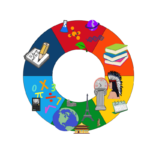AUDIO BOOKS: Listen to books or articles in audio format while reading a physical copy of the book or article.
learning skilLS
Sustained attention
Working Memory

instructional strategy
Audio Books
Use audiobooks with a physical copy of the book in front of the student. Encourage students to whisper/mouth, or read aloud while following along with the audiobook.
_________
LEARNING PREFERENCES
academic skill
Grade 3 – 9
READING COMPREHENSION: Understanding and Responding to Text- vocabulary

| Grade | Curriculum Focus | |||||
| 3-9 | demonstrate an understanding of a variety of words, acquire and use explicitly taught vocabulary in various contexts, including other subject areas, and use generalized morphological knowledge to analyze and understand new words in context | |||||
Lesson Objective, Goal and Success Criteria



UDL Instruction


Differentiated Instruction

Measurement of Success

Materials, References and Resources
Supplemental Documents
Pictionary Word Challenge Record Sheet
Link to worksheet for the Pictionary Word Challenge: Pdf link Word document link Reading Comprehension Responses Link to worksheet for the Reading Comprehension Responses: Pdf link Word document link